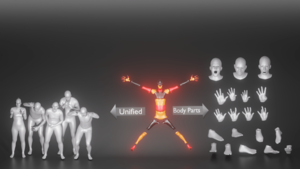SUPR: A Sparse Unified Part-Based Human Representation
2022
Conference Paper
ps
Statistical 3D shape models of the head, hands, and fullbody are widely used in computer vision and graphics. Despite their wide use, we show that existing models of the head and hands fail to capture the full range of motion for these parts. Moreover, existing work largely ignores the feet, which are crucial for modeling human movement and have applications in biomechanics, animation, and the footwear industry. The problem is that previous body part models are trained using 3D scans that are isolated to the individual parts. Such data does not capture the full range of motion for such parts, e.g. the motion of head relative to the neck. Our observation is that full-body scans provide important in- formation about the motion of the body parts. Consequently, we propose a new learning scheme that jointly trains a full-body model and specific part models using a federated dataset of full-body and body-part scans. Specifically, we train an expressive human body model called SUPR (Sparse Unified Part-Based Representation), where each joint strictly influences a sparse set of model vertices. The factorized representation enables separating SUPR into an entire suite of body part models: an expressive head (SUPR-Head), an articulated hand (SUPR-Hand), and a novel foot (SUPR-Foot). Note that feet have received little attention and existing 3D body models have highly under-actuated feet. Using novel 4D scans of feet, we train a model with an extended kinematic tree that captures the range of motion of the toes. Additionally, feet de- form due to ground contact. To model this, we include a novel non-linear deformation function that predicts foot deformation conditioned on the foot pose, shape, and ground contact. We train SUPR on an unprecedented number of scans: 1.2 million body, head, hand and foot scans. We quantitatively compare SUPR and the separate body parts to existing expressive human body models and body-part models and find that our suite of models generalizes better and captures the body parts’ full range of motion. SUPR is publicly available for research purposes.
| Author(s): | Ahmed A. A. Osman and Timo Bolkart and Dimitrios Tzionas and Michael J. Black |
| Book Title: | Computer Vision – ECCV 2022 |
| Volume: | 2 |
| Pages: | 568--585 |
| Year: | 2022 |
| Month: | October |
| Series: | Lecture Notes in Computer Science, 13662 |
| Editors: | Avidan, Shai and Brostow, Gabriel and Cissé, Moustapha and Farinella, Giovanni Maria and Hassner, Tal |
| Publisher: | Springer |
| Department(s): | Perceiving Systems |
| Bibtex Type: | Conference Paper (inproceedings) |
| Paper Type: | Conference |
| DOI: | 10.1007/978-3-031-20086-1_33 |
| Event Name: | 17th European Conference on Computer Vision (ECCV 2022) |
| Event Place: | Tel Aviv, Israel |
| Address: | Cham |
| ISBN: | 978-3-031-20085-4 |
| State: | Published |
| Links: |
Project website
Code |
| Attachments: |
Main Paper
Supp. Mat. Poster |
|
BibTex @inproceedings{SUPR,
title = {{SUPR}: A Sparse Unified Part-Based Human Representation},
author = {Osman, Ahmed A. A. and Bolkart, Timo and Tzionas, Dimitrios and Black, Michael J.},
booktitle = {Computer Vision – ECCV 2022},
volume = {2},
pages = {568--585},
series = {Lecture Notes in Computer Science, 13662},
editors = {Avidan, Shai and Brostow, Gabriel and Cissé, Moustapha and Farinella, Giovanni Maria and Hassner, Tal},
publisher = {Springer},
address = {Cham},
month = oct,
year = {2022},
doi = {10.1007/978-3-031-20086-1_33},
month_numeric = {10}
}
|
|





